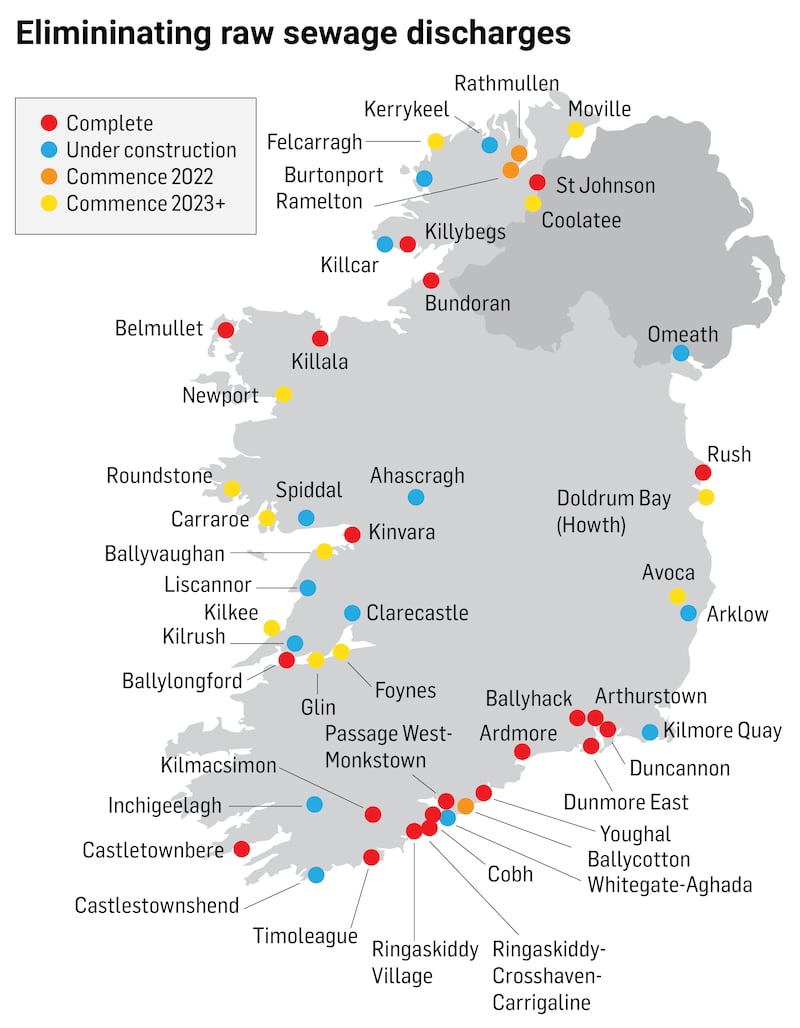Plans for a wastewater treatment plant in Arklow, Co Wicklow – the largest town in the State left without one – first emerged in 1993. After years of legal challenges and torn-up plans, builders began work last summer.
Such are the challenges faced by Irish Water, the relatively new utility charged with upgrading Ireland’s creaking infrastructure, which has found itself never too far from criticism.
There was more this week when the Environmental Protection Agency (EPA) published a report on Thursday which said just half of Ireland’s sewage was treated to EU standards last year.
As engineers race to get things up to scratch, they run a gauntlet of planning, financing and staffing challenges.
READ MORE
On Thursday, Irish Water was defending itself from EPA criticism that it lacked clear plans to deal with a third of priority areas where wastewater is adversely impacting the environment. It said 60 per cent of raw sewage discharge volumes had been eliminated since it took charge in 2014, noted 21 towns now had new treatment plants and said about half a billion euro had been invested in Dublin’s underperforming Ringsend plant.
But determined as it is to signal progress, much of the delays in outlining plans are procedural, outside of Irish Water control.
“I think really at the start we were a little bit optimistic and kind of eager to please around some of the dates we gave,” said its wastewater delivery manager, Michael Tinsley. “We learned the hard way that these projects are complex. We need to allow ourselves time, we need to stick to realistic timescales.”
Most treatment plants will take about five-seven years to deliver, but many projects prove stubborn.
In 2016, the EPA identified 50 towns with insufficient wastewater treatment standards. Of those, 21 treatment plants have been built and 14 are under construction. Most, Irish Water believes, will be finished by 2025.

“Everybody wants the treatment plant, not everybody wants the treatment plant beside them or on their land,” said Mr Tinsley.
Many of the project sites ended up under compulsory purchase orders (CPOs), and in some cases oral hearings which can add up to two years to delivery times. Two projects are currently under judicial review and one is subject to a separate legal challenge.
Irish Water must have ownership of the land before it can go to planning. Add to that design, environmental studies, community engagement and securing contractors, and the provision of treatment plants can be laborious. Land acquisition causes the longest holdups.
Arklow is a reluctant cause célèbre of such delays. An original treatment plant application was filed in the early 1990s, followed by another in 1999. There were local challenges and legal battles that progressed through the courts.
By the time Irish Water took over in 2014, the planning was about to expire and so it started fresh. This time, according to the utility, with extensive community engagement. After more planning, an oral hearing and eventual permission, a €139 million construction contract got under way in 2021. Irish Water estimates it will take four years.
“It [will have taken] us 11 years from start to finish with nothing going wrong,” said Mr Tinsley.
Whatever the delays, Irish Water will come under continuing scrutiny so long as the outstanding list of projects remains. About another two decades of work, by their own and EPA estimations. This will take billions of euro in investment, meaning cash flow in an era of economic uncertainty remains paramount.
As it is, Irish Water’s strategic funding plan which runs to 2024, requires €11 billion, including €6.1 billion for investment in infrastructure. This comes from State subvention and non-domestic revenues. It does not raise private funding through the markets but in June 2020, it entered State loan facilities.
Still, seven years after the suspension of domestic water bills, there remains a belief such income would have facilitated financial independence impossible under State funding.
In a 2012 submission to government, an Economic and Social Research Institute (ESRI) paper explained that independent income streams allow utilities to borrow independently.
Following the EPA report on Thursday, one of the ESRI paper’s authors, Prof John FitzGerald, said such a course would have made a big difference.
“What should happen is the regulator should say, here is what you have to do and then Irish Water would undertake the necessary investment. They could recoup the cost through water charges,” he said, describing the current model as unwelcome. “The environmental situation we face would not have been as bad if they had of been set up on an independent basis with water charges.”
Irish Water says little on the subject other than it continues to receive the financing it needs.
Skills too will be critical to delivery, and Irish Water concedes there is no “over-abundance”. It hires, runs a graduate programme and is looking into apprenticeships.
Currently it employs about 1,200 people and has service level agreements with about another 3,000 local authority water services staff.
When these agreements end in January, council workers – engineers, clerical grades, technicians and outdoor staff – will have the option to move to Irish Water, take up new roles where they are, or take severance.
Industry sources said staff were likely to both move and stay between next year and the end of 2025. While major new infrastructure projects are currently designed inhouse, the local knowledge of council workers is considered crucial to a relatively new organisation getting to grips with existing national infrastructure as they roll out more.












